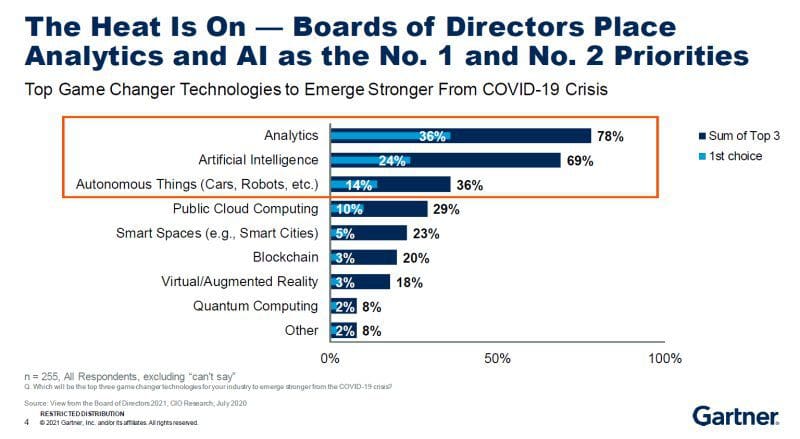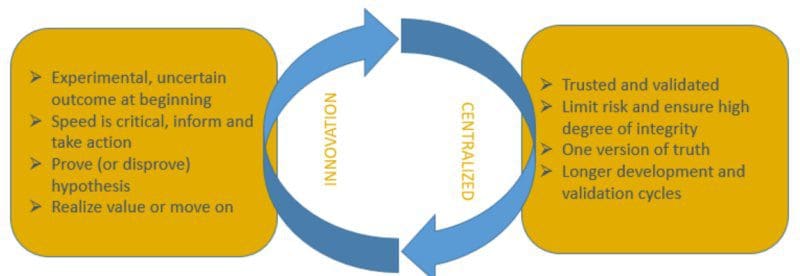Top 3 Challenges for Data & Analytics Leaders
The author shares the 3 top challenges faced as they led and established a data & analytics function, as well as ways in which these challenges were addressed. How have you solved the one challenge which has remained elusive to the author?
By Minoo Agarwal, Head of Informatics
As CDOs, CAOs and D&A leaders, we know that the key to success in this digital age is data. 2021 Gartner Board of Directors Survey cemented this into a fact when analytics and AI placed as top two focus areas for organizations. As the title states... the heat is on!
In the following article I share the 3 top challenges I faced as I led and established a D&A function. I also share ways in which I addressed some of these challenges — one, in particular, remains elusive, and I would love your thoughts on how you’ve solved it.
In the end, I’ve placed a poll of the top 10 challenges seen by CDOs, CAOs and leaders of D&A. Please interact if you can; it would be educating to see the challenges in your backyard.
Challenge #1: Data Literacy
We live in a time where every industry is assembling exponential amounts of data. But, while we may have all this data, there's still a big problem at hand: how do we get good at interpreting and making sense of it?
“Gartner defines data literacy as the ability to read, write and communicate data in context.” - Kasey Panetta
In my quest, I've learned it needs to be addressed at three essential levels.
First and foremost, basic learning dictates that you can’t use data to drive every action until you give every decision maker access to data and the tools to act on it. In essence, you have to approach data strategically — in a way that makes it available across departments and business users. This will amp up the data literacy and embed fact-based decision making into organizational culture.
Secondly, I’ve also been known to have TV screens installed that show the latest dashboards to encourage executive buy-in. Now, executives stand in the hallway to consult them daily; it publicizes how leadership makes decisions and sets an example for the entire enterprise.
However, the most important ingredient to improving data literacy was upskilling knowledge workers in the organization and give them hybrid roles. The goal was achieved as technical folks got better at analyzing data, and business folks got better at using tools and technology to drill in/down to gain actionable insights; we were able to increase data literacy across the organizational ecosystem.
Challenge #2: Measuring Value Creation
One of primary responsibilities of leaders of D&A is turning data from a cost center into a profit center: the challenge lays in measuring the effectiveness of your D&A strategy. How does one measure the realized return on investment (ROI)?
Dividing the problem into quantified (hard) and unquantified(soft) benefits helps.
Hard benefits such as new revenue streams, improved operations, improved customer engagement, cost reduction and risk avoidance can be quantified. This can be achieved by using financial models that incorporate cost, benefits and risks to get to the ROI, net present value (NPV), and payback period.
However, the causal link between D&A and soft benefits— like productivity gains or continued innovation across the organization from culture change — remains elusive for me. Though the impact is tangible, I haven’t found a way to build a model to anticipate or account for these intrinsic values.
If you have managed to quantify the intrinsic value of D&A, I would love to hear about it.
Challenge #3: Agility Vs Governance
With the democratization of data there is need to balance agility/innovation with risk/control. Better auditability, data lineage and ownership become table stakes when you’re in an industry with SOX, GDPR, FDA and HIPAA regulations. Enabling the organization to move at the rapid rate of growth without sacrificing security & governance (definition below) is a challenge.
Security
- Controls to limit data and content access
- Monitoring and logging
- Authentication
- Encryption
Governance
- Policies around who should have what data
- How content is created, promoted and shared
- Data Catalog, Lineage and certification of content and data
We've addressed it by making it a multi-lane street. We’ve empowered the organization with a sandbox environment to do experimental analytics with speed to prove a hypothesis. By starting with uncertain outcomes at beginning, we are able to realize value or move on.
While also having a centralized trusted, validated single source of truth that has longer development cycles at time, but limits risk. All 'enterprise' usage is churned out from this repository.
This dual approach allows for speed as well as limits risks. Once the value of the experimental analytics is proven, it can be part of the 'controlled' environment.
Additional benefits we've seen with governance:
- With centralized single source of truth, cut down on 'hunting for right data' and enabled faster time to market.
- Common definition of metrics and KPIs, eliminating inconsistencies
- Reduced duplicative work by promoting useful data and content for shared use across the enterprise.
Bio: Minoo Agarwal is a visionary and trusted C-level business partner and strategic thought leader who is passionate about helping companies rapidly improve their ability to compete by using data and analytics. Minoo has spent a career turning massive amounts of data into actionable business intelligence through predictive modeling, benchmarking and reporting. She has been fortunate to work, both as a consultant and on the inside, for many great companies. This has given her a unique perspective on what best-in-class performance is, and the challenges around implementing it.
Related:
- Who is fit to lead data science?
- Are Data Analytics and Data Science Two Separate Fields?
- How to Make Sure Your Analysis Actually Gets Used


